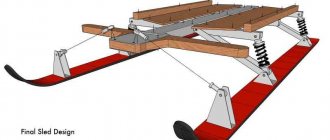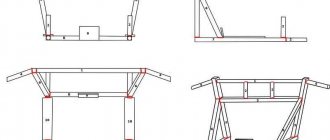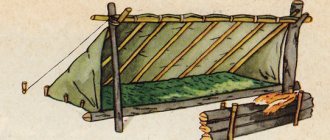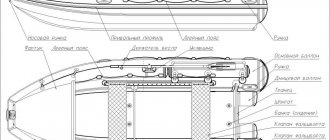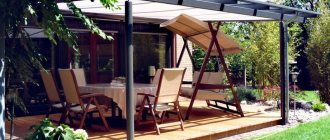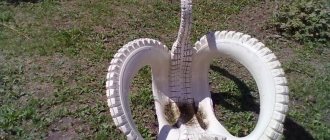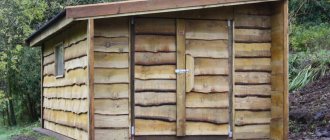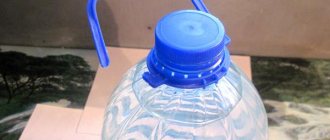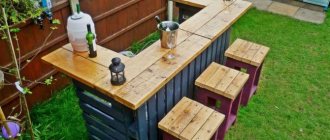How to dam a stream. How to make a pond in a ravine with your own hands
Many summer residents try in every possible way to decorate their site by digging ponds. This is not difficult to do if you know the technology of action. The main thing: take your time. In this article you will learn how to make a pond in the garden without effort, as well as the features of arranging a dam.
How to dig a pond in a ravine with your own hands
To dig a pond in a ravine with your own hands, you need to choose a suitable place. Choose areas that are away from plants and trees. Fallen leaves and branches should not pollute the pond. You should also choose places that are well lit by the sun. However, they should not be exposed to direct sunlight.
Did you know? The tallest dam in the world is the Dickens Dam, which is located in Switzerland. Its height is 285 m.
Try to locate the pond in a low area so that after precipitation and melting snow, the moisture flows into the pond and does not spill over the entire territory of the site. Quite often, a pond is dug next to the log, then it will be filled thanks to the stream.
Other features to consider:
Layout
First of all, you need to plan the site. If you make the pond deep, it will be too cold. Digging a small pond causes it to begin to bloom.
Experienced gardeners recommend making a pond 2.5 m wide and 1.3 m deep. To facilitate the work process, you can use special equipment.
Work process
The operating technology is as follows:
How to make a pond from a stream in a ravine
If you decide to dam a stream in a ravine, then follow these instructions:
How to design a ravine for a pond
To create a ravine for a pond, you need to cut off all the steep walls. It is best to do this before building the embankment to prevent soil from getting into the water.
Important! Aspen panels are necessary to ensure that over time the earth does not slide back into the reservoir.
The actual embankment should be slightly higher than the plan. The optimal discrepancy is 8%.
How to make a dam
It is best to immediately make a dam during excavation. You can use a stream or catchment for this. It is recommended to block the reservoir in the narrowest part.
The technology is as follows:
The width of the embankment should be 1–1.5 m. This is necessary so that the structure can withstand the flow of water. The dam can be filled after the dam has stood for a few days to secure the structure.
So, now you know how to make a beautiful pond at home. Try to choose the right place to work to avoid unpleasant situations. If all the steps are performed correctly, you will be able to decorate your garden with unusual ponds.
Production of hydroelectric power station based on a water wheel
Of course, assembling and erecting a colossus designed to serve an enterprise or settlement of even a dozen houses is an idea from the realm of science fiction. But building a mini-hydroelectric power station with your own hands to save electricity is quite possible. Moreover, you can use both ready-made components and improvised materials.
Therefore, we will consider step by step the manufacture of the simplest structure - a water wheel.
Required materials and tools
To make a mini-hydroelectric power station with your own hands, you need to prepare a welding machine, an angle grinder, a drill and a set of auxiliary tools - a hammer, a screwdriver, a ruler.
Materials you will need:
- Corners and sheet metal with a thickness of at least 5 mm.
- PVC or galvanized steel pipes for making blades.
- Generator (you can use a ready-made one or make it yourself, as in this example).
- Brake discs.
- Shaft and bearings.
- Plywood.
- Polystyrene resin for casting the rotor and stator.
- 15 mm copper wire for a homemade generator.
- Neodymium magnets.
Please note that the wheel structure will constantly be in contact with water, so metal and wooden elements must be selected with protection from moisture (or take care of impregnation and painting them yourself). Ideally, plywood can be replaced with plastic, but wooden parts are easier to obtain and shape into the desired shape.
Wheel assembly and nozzle manufacturing
The basis for the wheel itself can be two steel disks of the same diameter (if it is possible to get the steel drum from the cable - great, this will greatly speed up the assembly process).
But if metal is not found in the materials at hand, you can cut circles from waterproof plywood, although the strength and service life of even treated wood cannot be compared with steel. Then you need to cut a round hole on one of the disks for installing the generator.
After this, the blades are made, and at least 16 pieces will be needed. To do this, galvanized pipes are cut lengthwise into two or four parts (depending on the diameter). Then the cutting areas and the surface of the blades themselves must be polished to reduce energy loss due to friction.
The blades are installed at an angle of approximately 40-45 degrees - this will help increase the surface area that will be affected by the flow force
The distance between the two side discs should be as close as possible to the length of the blades. To mark the location for future hubs, it is recommended to make a template from plywood, which will mark the location for each part and the hole for fixing the wheel to the generator. The finished markings can be attached to the outside of one of the disks.
The circles are then installed parallel to each other using solid threaded rods, and the blades are welded or bolted in the desired positions. The drum will rotate on bearings, and a frame made of angles or small diameter pipes is used as a support.
At this stage, the assembly of the drum can be considered complete; all that remains is to equip it with a homemade generator and a nozzle that directs the flow of water
The nozzle is designed for cascade-type water sources - such an installation will allow you to use the flow energy to the maximum. This auxiliary element is made by bending sheet metal, followed by welding the seams, and then mounted on a pipe.
However, if your area has a flat river without rapids or other high-altitude obstacles, this detail is not necessary.
It is important that the width of the nozzle outlet corresponds to the width of the wheel itself, otherwise part of the flow will go “idle” and not reach the blades
Now the wheel needs to be mounted on the axle and mounted on a support made of welded or bolted corners. All that remains is to make a generator (or install a ready-made one) and you can go to the river.
DIY generator
To make a homemade generator, you need to winding and filling the stator, for which you will need coils with 125 turns of copper wire on each. After connecting them, the entire structure is filled with polyester resin.
Each phase consists of three skeins attached in series, so the connection can be made in the shape of a star or triangle with several external leads
Now you need to prepare a plywood template that matches the size of the brake disc.
Markings are made on the wooden ring and slots are made for installing magnets (in this case, neodymium magnets 1.3 cm thick, 2.5 cm wide and 5 cm long were used). Then the resulting rotor is also filled with resin, and after drying, it is attached to the wheel drum.
Water wheel with a rotor made of brake discs and a generator made of coils of copper wire - painted, presentable and ready for use
The last thing to install is an aluminum casing with an ammeter covering the rectifiers. The task of these elements is to convert three-phase current into direct current.
After installing the wheel in the flow of a small river with a cascade or outlet pipe, you can count on a mini-hydroelectric power station performance of 1.9A * 12V at 110 rpm
To prevent leaves, sand and other debris brought with the flow from getting into the wheel, it is advisable to place a protective net in front of the device.
You can also experiment with the gaps between the magnets and coils with an increased number of turns to increase the efficiency of the hydraulic station.
You will learn about all types of alternative energy sources by reading the article dedicated to the introduction of “green technologies” into everyday life.
Strengthening the pond dam. Gabions
Carrying out work with gabions is simple and economical. The advantages of using such structures include the following:
It is not difficult to make such a design. In this case, you should follow these recommendations:
The gabion structure reaches maximum strength parameters after 5 years of use. During this period of time, the coastline becomes one with the landscape.
Box-shaped
It is possible to make gabions yourself. For this purpose, metal mesh and wire are used. In this case, you will be able to save money. However, the manufacturing process takes time. A box-shaped structure is perfect for strengthening the bank. When making gabions, you can use welded joints or tie them with wire. The first ones are considered durable. They can be quite large.
When choosing the second connection method, it is worth making a smaller product.
The height of the structure is 30-40 centimeters. Its length should be 1.5-2 meters, and its width should be 1. When making it yourself, all procedures should be done at the intended location of the gabion. It is also recommended to fill it with stones. When purchasing ready-made gabions, special equipment will be required.
Cylindrical
To make cylindrical gabions, a softer mesh is used. Double torsion steel is suitable for this purpose. The result is a design that resembles a so-called candy. Cylindrical gabions are made faster than box-shaped ones. They are made 2-4 meters in length, 65-95 centimeters in diameter. The resulting structures are placed along the coastline, making them a kind of embankment. Usually 2-3 tiers filled with stones are enough.
Gabion matrix
This term refers to flat and wide structures. They are convenient and highly efficient. Such gabions should be laid in 1-2 layers. To do this, do the following:
After 1-2 years, compaction of the stones is observed. As a result, voids will appear in the structure. There is also a risk of the mesh sagging. Adding new stones will help solve the problem. It is worth choosing their sizes correctly. This is done taking into account the cell size.
How to make a pond with your own hands for fish farming
Fish can be grown in a variety of types of bodies of water, both natural and man-made (lakes, small ponds and reservoirs, exhausted quarries and swimming pools).
To breed fish at home, it is necessary to equip a special reservoir, while observing certain requirements.
Selecting a location
First of all, hydraulic and fish breeding requirements must be observed. The structure of a reservoir for keeping fish has significant differences from swimming pools for decorative purposes. Recommendations for arrangement are shown in Figure 1.
When equipping reservoirs for breeding, the following rules must be observed::
Figure 1. Rules for arranging a fish tank The size of the reservoir is determined not only by the number of fish grown, but also by the size of the personal plot. They are often used in combination (not only for growing fish, but also for watering or breeding waterfowl). There are several types of ponds: dug, channel and diked. Bunded ones are considered the best, since it is easier to create natural conditions in them. Construction options are shown in Figure 2.
To set up a pond, several important conditions must be met.:
Figure 2. Options for constructing a pond and treating its walls and bottom When choosing a location, pay special attention to the soil. The soil must have low moisture permeability. Otherwise, the water will simply be absorbed by the ground. In terms of soil, clayey, loamy and meadow areas are considered the best. If the site has predominantly sandy soil, the bottom and walls of the reservoir should be covered with film and lightly sprinkled with earth.
Types of ponds
An important condition for the operation of reservoirs is the provision of water. Its quality and quantity will subsequently become the decisive factor determining suitable varieties of fish (for example, trout requires the cleanest water without foreign impurities and odors). To determine whether the water is suitable for dilution, you need to submit appropriate samples to the laboratory.
There are several types of ponds depending on the method of water supply:
More useful recommendations on the arrangement and water supply of a pond are in the video.
There are several types of reservoirs intended for fish farming. For example, you can use peat quarries and workings. To improve the quality of the soil, the bottom of such quarries is covered with lime. As a rule, such models do not require the installation of hydraulic structures, since filling occurs using groundwater. However, in such reservoirs it is impossible to drain the water, so to prevent water from blooming and polluting the bottom with silt, you need to ensure that the fish population does not exceed the norm.
Construction of ponds, sewage pits or ditches
Owners of country houses are often interested in how to dry a plot of water with their own hands without drainage. This is also possible, but it is best to use such methods in the country, and not in a country house. This is digging ditches, sewage pits or decorative ponds. They can become not only a means of draining water, but also an element of landscape design. The choice of method depends on the characteristics of the site and the reason for the accumulation of moisture.
Note ! The disadvantage of this method is the need to regularly clean the resulting reservoirs. Without this, they will bloom, mosquitoes will appear, and there will be an unpleasant smell.
Wells
The easiest way is to dig holes in the lowest flooded areas. They should be cone-shaped, tapering downwards. The diameter at the surface is 2 m, the depth is at least 80-100 cm. Such pits can be decorated by turning them into decorative ponds. To avoid shedding and silting, their bottom is covered with gravel.
Ditches
Ditches are more difficult to dig, but such a system will drain excess water more efficiently. They are organized around the perimeter of the site. To prevent the walls from crumbling, they are reinforced with boards or concrete slabs. You can put a metal box on the bottom.
Drainage ditch beautifully designed to look like an artificial stream Source kndlandscaping.com
A variant of this drainage method is the installation of decorative streams. This is appropriate if the site is located on a slope. The bottom of the artificial stream is laid out with pebbles, pebbles or geotextiles. It is recommended to arrange streams under trees, as in a sunny place the water will bloom.
Dam structure
The soil, rock-soil dam consists of several parts. In cross section it looks like this:
With another construction method, the entire structure can be composed of homogeneous permeable soil (sand, sandy loam, gravel). Clays and other rocks that retain moisture are not used in the body of the dam. They can be used to make a dense base for a structure or a clay castle.
A highway or railroad can run along the top of the dam. In this case, the height above the water must be appropriate so that the canvas does not flood even at the highest water level (at least a meter above high water). The width depends on the width of the road and must correspond to the design stability parameters.
What everyone should know about vibratory hammers
For other dams (in country gardens, private farms), half a meter above the water level is enough. The width of the ridge varies: in a small pond - about a meter. The ratio of the width of the sole to the height of the structure is 2.5 to 1.
In high slopes, to increase stability, horizontal steps are made - berms, in increments of 2-8 meters.
Types and functions of a dam
Dams have different purposes:
- installation of a reservoir for fish breeding in the water area;
- construction of protective dams to correct water flow and prevent destruction of buildings by an avalanche of water;
- construction of hydroelectric power stations;
- anti-surge (anti-wave) dams – sea. For example, breakwaters. Constructed to protect the coast from tsunamis, storm surges and other hazardous factors;
- the construction of a pond dam in a dacha community may be required for landscaping, the dam itself may be required for fire fighting and other economic purposes, etc.
For your information
Depending on their purpose, dams can be either pressure or non-pressure. The former are used as protective structures, the latter - for channel correction.
In relation to a reservoir, a dam can be contour (along the perimeter of the shore) or dividing (for example, an isthmus between paired ponds). Separators are symmetrical. The contour slope facing the water is opposite.
The dam can be of artificial or natural origin. Natural ones are river jams made of logs deposited by the flow over time, beaver dams and the consequences of other natural factors.
How we made sheet piling during the construction of a temporary bridge in Noginsk
An artificial dam can consist of various materials:
- priming. These dams are divided depending on the method of construction into bulk, alluvial, explosive (formed by a directed explosion);
- made of stones or masonry;
- concrete;
- stone-earth.
The structure can be permanent or temporary. The construction of a temporary dam is required, for example, in the event of a flood: it is needed while the water level in the reservoir is high, and in a normal situation it will only interfere with the normal flow.
You can order the construction of a dam on sheet piles from our company
The price of installation, transportation of piling and drilling equipment is the lowest in the region.
For any questions call: 8
DIY fish pond without film
The simplest fish pond that you can build with your own hands is a structure with a dirt bottom and walls. The pit must be carefully compacted, but still this structure is considered not strong enough and comfortable for fish, so it is better to use film as the main covering.
Figure 6. Bottom drains: a - regular (1 - grate, 2 - riser, 3 - flaps, 4 - dam, 5 - deck chair), b - simplified (1 - head, 2 - deck chair, 3 - valve gate, 4 - winch, 5 - fish catcher), c - drainage without riser (1 - hole, 2 - shield, 3 - rod for lifting the shield, 4 - grooves for the movement of the shield, 5 - concrete head, 6 - dam slope)
In fact, the technology for constructing a pond for breeding fish from film and without it is practically no different at the initial stage. Differences appear only at the end, when the bottom and walls of the pit are covered with polyethylene.
Peculiarities
The most important feature of creating and arranging a pond is the correct choice of location. It is desirable that the soil be clayey, since such soil retains water well (Figure 8).
Figure 7. Types of fish traps
In addition, it is better to build a reservoir on the southwest side so that the water is warmed by the sun for at least 4 hours a day. It is not advisable to locate the pond under the shade of deciduous trees, as falling leaves will pollute the pond.
It is important to correctly calculate the depth of the reservoir. The optimal depth is one and a half meters, but it is better to increase this figure to two meters, and if you are going to grow carp, then to 2.5 meters. This feature must be fulfilled so that the fish can be in the pond not only in summer, but also in winter.
Construction technology
To make a pond on a fish breeding site, you need to follow a clear sequence of actions.
Step-by-step instructions for building a pond include the following steps:
Figure 8. Stages of constructing a pond without a film. At the final stage, landscaping of the pond is carried out. A special substrate is placed at its bottom, in which aquatic plants are planted. You can also decorate the bottom with stones or broken pots if you plan to grow not only fish, but also crayfish. After this, you can begin installing the pump, filling the pond with water and stocking the fish.
When is it necessary to drain the area?
Large puddles appear in a suburban area when water does not seep into the ground during rains or floods. This happens if the soil is clayey or the groundwater level is high. And if the area is in a lowland, water flows onto it from above. The presence of large bodies of water or swamps nearby also affects the humidity level.
In all these cases, for normal living and harvesting, it is necessary to drain the area from groundwater. The problem can be detected in spring or autumn. Flooding usually occurs in the off-season, when the snow melts or there is a lot of rain. You can see places where moisture accumulates.
If a plot of land is purchased in the summer, you can also understand that it is flooded. This is detected by the following signs:
- doors and frames are warped, cracks are visible on the walls;
- smell of dampness, mold visible in the corners;
- there is water in the basement;
- a lot of mosquitoes, snakes, frogs;
- Weeds are dominated by nettle, wormwood, hemlock, and also a lot of reeds.
Prolonged accumulation of moisture near the house will lead to the appearance of mold, unpleasant odor, and deformation Source stroyfora.ru
design, installation and strengthening
Our construction company carries out work on the construction of a dam with reinforcement of slopes with metal piles in Moscow, the Moscow region and other regions of the Russian Federation.
A dam is a trapezoidal earthen embankment (or concrete structure) on the territory of a reservoir, the function of which is to create a barrier to the free movement of water. An analogue of a dam, only with a simplified design and designed for lower loads. Dams are often constructed from reinforced concrete; the main material for dam construction is soil.
How to order the construction of a dam in our company
We sell sheet piling and install sheet piling throughout the Russian Federation. We carry out all the work starting from cycle zero:
- hydrogeological studies, initial soil assessment;
- pile testing;
- design;
- installation and strengthening of the structure;
- when constructing a temporary dam - dismantling the wall at the end of use, removing and purchasing the sheet piles. In case of redemption, we will refund you up to 80% of the original cost of the material.
Important!
We carry out all types of work that require the installation of sheet piling walls:
- fencing trenches for communications, construction pits;
- strengthening the coastline and any hydraulic structures - dams, bridges, piers;
- underground sewers, landfill fencing, etc.
At our clients' service:
- low prices. We will help you choose the most economical option for cooperation;
- high-quality imported equipment and experienced staff;
- SRO certificate, permission to carry out work at particularly critical facilities;
- a large selection of tongues with various technical characteristics;
- fast deadlines.
Creating a pond without concreting
A pond without concreting is created using the same technology, but since concrete is used to strengthen the walls and bottom of the reservoir, you will have to find an alternative arrangement if you do not plan to use concreting.
In this case, you can simply thoroughly compact the soil in the reservoir or cover the bottom and walls with film. The latter method is considered the best, since plastic film greatly facilitates the process of cleaning the pond in the fall.
Peculiarities
There are no significant features that distinguish the construction of a pond from film and without concreting. To do this, you also need to choose a suitable place with a flat area and dense clay soil (Figure 9).
A prerequisite is to calculate the size of the reservoir. On average, 10-20 individuals need 10 liters of water. Based on this indicator, you can calculate the volume of an artificial reservoir and determine the optimal area.
Rules
According to the rules, construction of a pond without concreting begins with markings. It can be made using sand or a cord that is stretched around the perimeter of the future reservoir.
At the next stage, they begin to dig a pit. Its depth should be 2 meters, but for further arrangement of the bottom, the pit is made a little deeper. After this, in the case of using concrete, the bottom and walls are filled with mortar, but if you do not plan to use concrete, you need to carefully compact the bottom and walls, or cover them with thick dark plastic film.
Figure 9. Construction of a home pond without concrete
In the future, they will begin to develop the banks and the reservoir itself. The banks need to be strengthened so that the soil does not slide into the pond and clog it. A special nutrient substrate is placed at the bottom and aquatic plants are planted.
When arranging a pond without concreting, it should be borne in mind that this design is considered the simplest in the construction process, but in the future it may be difficult to clean the pond from silt, so it is better to use film or concrete as the main covering of the bottom and walls.
If the water in the pond does begin to bloom, the tips from the video will help you cope with this problem.
Construction of dams and dams using metal sheet piles
Due to their configuration, soil and earthen dams take up a lot of space, which makes their use in small reservoirs problematic. To reduce dimensions, the walls are compressed. The shape of such a dam differs from the classical one: only the upper part is trapezoidal, and the lower (sheet pile) walls are vertical.
Over time, the soil is eroded, and the earthen dam settles down, “spreading” along the bottom. To prevent this from happening, the walls of the structure are strengthened. The optimal method of strengthening is also tongues: metal, in some cases PVC or composite.
Sheet piling can be used to “sheath” a new dam or strengthen an old one. Strong walls allow the embankment to be used in any capacity, including for the construction of railways and roads.
Compare our prices for sheet piling with those offered by competitors and draw your own conclusions!
Are you building a pond? Make no mistake!
There is probably no point in convincing anyone that a pond in the garden is good. Water attracts everyone’s attention like a magnet and even in photographs always looks mysterious and alluring. Is it any wonder that today a reservoir has become an indispensable attribute of the “gentleman’s set” of any design project for the development of a new plot of land or the reconstruction of an old one.
Pond in the garden. Photo by Valeria Ilyina
Unfortunately, as a result of a formal approach to business, one garden becomes similar to another. Professional designers churn out gardens like they bake pies; they actually turn out cloned. To be honest, I am closer to the gardens of amateurs, who, although they are guilty of some amateurism, still attract more with their ingenuous soulfulness.
We invite you to familiarize yourself with Peacock photos, descriptions, nutrition, reproduction
To make the path to beauty shorter, let's try together to analyze the characteristic mistakes that are surprisingly repeated in many bodies of water, and analyze their nature. And after that, we will step by step analyze all the subtleties and secrets of quickly, easily and economically creating a reservoir that is ideal for your garden. So, the most typical mistakes.
Stone beads
The most common mistake in decorating a garden pond is rounded cobblestones laid out around the entire edge, like beads. Most often such beads lie in one row, but some manage to stack two rows on top of each other.
Cobblestones laid out in a row do not hide the edges of the form and look unnatural. This method of laying stones will never look natural, not to mention the fact that it is completely impossible to decorate the film or side of a rigid structure. So the multi-colored “monists” lie on monstrous black banks, and no matter what beauty you arrange around, such an aqua garden will serve as a silent reproach to the owner.
When relaxing on the banks of rivers and lakes, try to pay attention to how nature “lays out” the stones, and what you like and remember most. Typically, small fractions serve as a background, and larger fractions stand out texturally in contrasting groups.
The stone for decorating a pond must be carefully selected. Photo by Valeria Ilyina
Conclusion: the stone for decorating a pond must be carefully selected. It is advisable to use a stone that is uniform in type and color, but varied in size. This does not mean that the pellets are completely unsuitable, but in order for them to “play”, you need to work with them even more carefully.
Calculation of water volume
Due to incorrect calculation of the volume of water, the construction of a ringing stream may fail. It should be taken into account that the pump pumps water over a fairly large distance, which is equal to the duration of the stream. On the way back, the movement of water slows down due to the fact that it goes around stones and plant stems.
Diagram of a stream filled with water
If you decide to calculate the volume of water yourself, then take into account the area of the base of the stream, the height of the water column in the stream and its volume in the hose laid under the stream and supplying water to the highest point of the source and plus the volume of the lower pond.
Moisture-loving plants
If you are wondering how to drain a site with your own hands at no cost, you can consider the option of planting moisture-loving plants. This method will be effective only in small swamps and if there is no urgent need to remove water.
By using plants that require a lot of water, you can lower the groundwater level and speed up the drying out of the area after rains and floods. This will also help decorate the area. Willow, maple, poplar, alder and birch are used.
If you need plants that grow faster, you can plant shrubs: hawthorn, viburnum, serviceberry, rose hips. This is an ideal way not only to reduce the amount of water on the site, but also to create a hedge. There are also moisture-loving herbaceous plants. These are perennial flowers: iris, aster, aquilegia. You can plant cranberries and blueberries.
To remove excess moisture, moisture-loving plants are planted on the site Source yandex.net
Wrong size
. A small puddle located somewhere near the fence or at the entrance to the garden and sandwiched on all sides by lush and beautiful garden plants, no matter how hard you try, will always look miserable.
The size of the reservoir must be correlated with the surrounding space
But this does not mean at all that a small body of water (for example, in the form of a spring) cannot decorate the garden at all. Simply by choosing this or that image, you need to correlate it with the surrounding space. If you don’t have room in your garden for a large pond, perhaps a selection of miniature ponds: a dozen simple ideas will help you find a solution. A successful example is also presented in the publication Saucer of Water as the completion of a dry stream.
Source
Briefly about the main thing
If the site is located on clay soils or in a lowland, it may need to be drained.
This procedure is complex, but quite feasible. If you choose the right drainage method, taking into account the characteristics of the soil and the depth of groundwater, you can get rid of the problem.
For this purpose, open or closed drainage is most often used, ensuring the outflow of water into drainage wells.
If the area is very waterlogged, it may need to be raised. And to get rid of moisture during rains, it is enough to plant moisture-loving plants on the site.
Dam construction technologies
Depending on the load the hydraulic structure will bear, the material for constructing the dam can be:
Rules for the construction of an earthen rampart
When constructing an embankment dam, a common misconception is the use of homogeneous chernozem, sandy or clayey soils. Chernozem and sand allow water to pass through, acting as a kind of filters, while clay easily erodes and forms cracks when temperatures change. Through them, spring floods easily penetrate into the coastal zone, causing damage to farmsteads or the natural ecosystem. A mixture of loam and sand is best suited for building an embankment.
In how to make a dam on a stream with your own hands correctly, adherence to a certain technology plays an important role. For the construction of an embankment, it is more practical to select the narrowest point of the future dam. This will save effort, time and reduce material costs.
Before starting construction, you need to measure the maximum depth of the man-made reservoir, the cross-section of the bed (width multiplied by depth) and the speed of water flow. This is necessary in order to calculate the volume of water carried by the stream per unit of time (liters per second). Based on these calculations, it is possible to determine the dimensions and material for the dam structure. During excavation work, it is better to redirect the stream flowing along the bed of the lake to another channel by digging a ditch parallel to the flow of water.
Stages of building a hydraulic structure from soil
Concrete enclosing structure
It is appropriate to erect a concrete dam between the cascading ponds. For concreting, you need to choose waterproof cement or add liquid glass and PVA glue to the mixture for greater concrete strength. The finished structure can also be impregnated on the outside with liquid glass.
The dam should be reinforced with 10 mm rods, a 40x40x5 mm angle and masonry steel mesh. During construction work, the construction area can be fenced off on both sides with sides made of soil to prevent water from entering the workplace.
Drainage design for establishing water exchange in the pond
Overflow of a man-made reservoir leads to its volley release, which can cause significant harm to nearby areas. In order to avoid critical situations, and also to be able to drain the pond along with the dam, a drainage system should be constructed. The simplest and most effective in this regard is the “Monk” design, first used in the fisheries of ancient monasteries.
Subtleties of constructing the “Monk”
The Monk spillway should be installed at the deepest point adjacent to and level with the dam. Two hydraulic structures should be connected using a special bridge.
The drainage structure consists of a riser and a deck, hermetically connected to each other at right angles. In the riser, it is necessary to place adjustable holes for water overflow, the control levers for which are sand boards. The monk consists of two levels: in the first, water is collected from the bottom of the reservoir, and from the second it is poured into a special drain pipe and discharged into a ditch.
